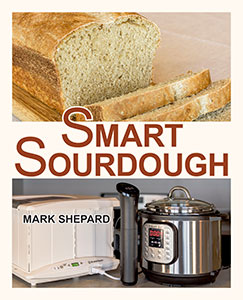I’ve been making sourdough bread for much of my adult life. I even wrote a booklet called Simple Sourdough that has been a steady seller on Amazon for a decade and a half. For the past few years, though, I’ve been working on a brand new approach to sourdough—a method that takes 24 hours or less, from start to finish, with no need of a starter.
Developing this has involved research into recent scientific studies and the evolving practices of professional and amateur bakers. When I delved into those, I quickly learned that a new-found popularity of sourdough went hand in hand with a surge of interest in fermented foods in general. I was fascinated to learn of studies of a beneficial ecosystem of microbes in our digestive systems—an ecosystem that could be enhanced by fermented foods.
Of course, sourdough, healthful though it is, does not contribute to this ecosystem, since its microbes do not survive baking. Natural pickles, which I’ve made occasionally, do contribute—but they’re more of a treat for me, not a regular part of my diet. Still, I figured I had this covered with unpasteurized yogurt, which I’ve eaten almost daily for decades and even made myself for a while, using store-bought yogurt as starter.
Then I discovered that all yogurt sold in stores is made with one or other artificial blend of just several isolated microbe species. It’s not traditional yogurt—which is made with much more diverse cultures—and it’s not truly natural, either!
The New/Old Sauerkraut
I figured I’d do well to find some regular source of live natural culture for my diet. I wound up trying a food that was relatively new in stores: naturally fermented sauerkraut. I have to admit, I expected to hate it, since I always had hated sauerkraut. Couldn’t stomach it, period.
But it turned out there’s a huge difference between common supermarket sauerkraut, made by adding vinegar to cooked cabbage, and traditional sauerkraut, naturally fermented and soured. In fact, there’s no comparison! The natural product is absolutely delicious!
I started eating it once, twice, sometimes three times a day. I have to admit, I went a bit crazy with it, for a time. And some friends and loved ones may have gotten tired of my raving about it.
The Dental Connection
What does all this have to do with dental health? Well, up to this time, I’d been going through a period with a fair amount of tooth decay. I was getting my teeth cleaned every three months, and it seemed like, almost every time I did, the dental hygienist would discover a new cavity. But two or three months after starting to eat the sauerkraut, I went again, and there was no new cavity. And the same happened on my next visit.
At this point, I was starting to suspect the sauerkraut was helping in this. But when I mentioned the idea to my hygienist, she said she didn’t imagine there was any scientific study to support that idea.
That got me wondering, so I went looking. True enough, I could find no studies of the effects of sauerkraut on tooth decay. But there was research on the microbial ecosystem in the mouth and how dental health is affected by lactic acid bacteria—a general family of bacteria that includes species that ferment food like sauerkraut.
Some species of this family, it turns out, are closely linked to production of tooth decay—the exact opposite of what I was looking for! But then there are different species associated with mouths that are cavity-free. So, the idea that dental health could be improved by naturally fermented foods, with their specific collections of live bacteria, was not at all far-fetched.
Shortly after, I began experimenting with another change in diet. The sauerkraut, no longer fitting in as well, got shunted to the side. And on my next teeth cleaning . . . I had new tooth decay.
After that, I made sure my diet made room for a serving of sauerkraut almost every day. And in the five years since, I have not had a single new cavity.
A Cautious Inquiry
Now, I’m not going to tell you that sauerkraut will stop you from having cavities. I won’t even tell you it’s for sure the reason I haven’t had any myself. I can’t prove a thing, and I know it! And even if I’m exactly right about what it has done for me, it might not work the same for you. (So, you see, I’m not a total crank.) But I do want to share my experience for those who might be inspired to experiment further on their own.
As to details, the brand I’ve mostly eaten is Bubbies Sauerkraut. (And before you ask . . . No, I have no affiliation with the company.) It’s a completely natural product, available in the refrigerator sections of food markets in the U.S. and Canada. But possibly any naturally fermented sauerkraut would have similar effect, and so might its Korean kissing cousin, kimchi. Nowadays such products are easy to find, at least in many areas.
In fact, any naturally fermented pickle might do, since that’s what sauerkraut and kimchi are—pickled cabbage. You could even learn to make your own. Personally, though, I’m glad to have the convenience of picking up a jar from the store every couple of weeks.
To my mind, it’s a small price to pay for freedom from cavities.
